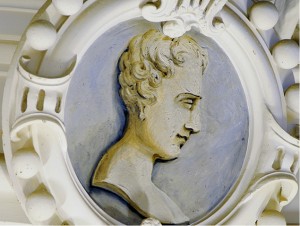The history of Harlaxton Manor as it stands today begins with its builder, the mysterious Gregory Gregory (1786-1854).
Gregory Williams was the only son of Olivia Preston (1758-1835) of Flasby Hall, Yorkshire and William Gregory Williams (1742-1814), who served in the Royal Foresters regiment for much of his life. William Gregory added Williams to his name on inheriting his grandmother Susanna Williams’ family estate, and had Rempstone Hall built in 1792.
By 1822 Gregory Williams had inherited estates from his father and his uncle’s legacies, and took on the Gregory name becoming known as Gregory Gregory. The estate of his uncle, George de Ligne Gregory (1740-1822), included considerable property in Nottingham, Lenton, and Radford, and holdings in various canal and railway companies. The Radford property contained coalmines and amongst papers is a receipt for coal sales by Gregory Gregory for £10,569. In addition to land at Rempstone, the Williams family estates also included a smaller property at Denton. George de Ligne Gregory’s will settled his estates on his three brothers and their issue successively, and failing them, on John Sherwin, the family solicitor and a distant relation.
How Gregory Gregory employed himself before inheriting his estates is not known with certainty. In 1797 aged 11, he gained entrance to Rugby School in Warwickshire. In 1805 at the age of 19 he attended Christ Church College, Oxford as a commoner or ordinary fee-paying student. He studied Classics, Greek philosophy and Mathematics but left in 1807 without taking a degree. Many young men came up to Oxford almost as a finishing school or a rite of passage, many were destined to run family estates or even family businesses, and left around their 21st birthdays to carry on their responsibilities.
Gregory Gregory received a commission as a Major in the second or Southwell Regiment of Local Militia in 1809 and was promoted to Lieutenant Colonel in 1813. In 1823 Gregory Gregory of Rempstone is listed as a Fellow of the Royal Horticultural Society. In 1825, still based at Rempstone, he acted as Sheriff of Nottinghamshire, as many of his ancestors had done before him. At this time Gregory let out Rempstone Hall to Mr Smith Wright of the Nottingham banking family, and he moved to Hungerton Hall. An 1829 Directory lists him as living at Hungerton Hall and in 1831 he can be found as a Fellow of the Zoological Society of London.
Sir Charles Welby, writing in 1937, notes that as a young man Gregory ‘is said to have been attached to some of our embassies abroad so was in a position to indulge in the then fashionable craze for acquiring foreign works of art.’ It is likely that after 1822 these purchases increased as he sold plots of land in Lenton and Radford, and with a view to the palatial mansion which he was to build, Gregory amassed the collection of statuary, furniture, tapestries, books, silver plate, and those few pictures which later became known as the ‘Gregory Heirlooms.’ The Stamford Mercury reported in March 1831 that “Gregory Gregory, Esq. of Hungerton, arrived at his residence … after three years residence in France and Italy. He is about to commence the erection of a splendid mansion on his estate at Harlaxton, of the Elizabethan style of domestic architecture.”
There is evidence that Gregory visited for inspiration not only Burghley, Montacute, Hardwick, Hatfield, Knole, Rushton, Kirby, Longleat, Wollaton, Cobham, Hengrave and Bramshill, but also houses on the Continent. The contents of his library at Hungerton Hall would have also given him European inspiration.
The Gregory Family Tree by Dr Mark Valenzuela


